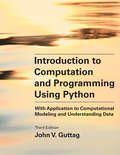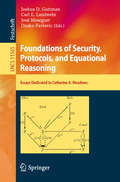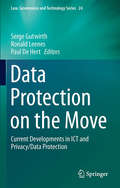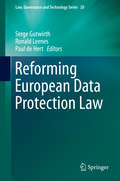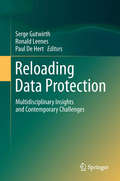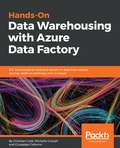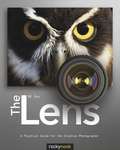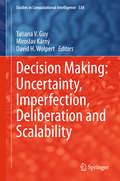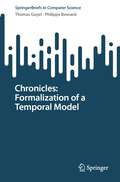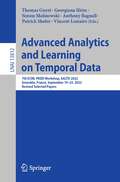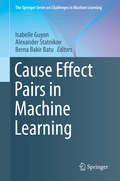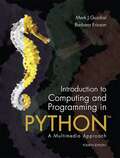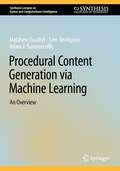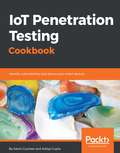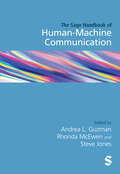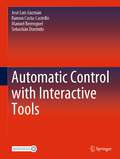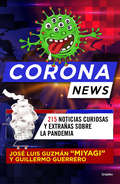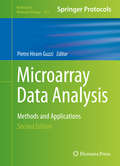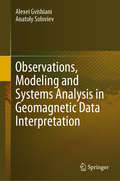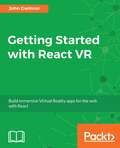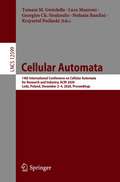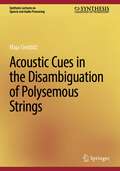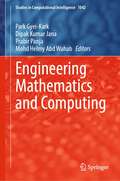- Table View
- List View
Introduction to Computation and Programming Using Python, third edition: With Application to Computational Modeling and Understanding Data
by John V. GuttagThe new edition of an introduction to the art of computational problem solving using Python.This book introduces students with little or no prior programming experience to the art of computational problem solving using Python and various Python libraries, including numpy, matplotlib, random, pandas, and sklearn. It provides students with skills that will enable them to make productive use of computational techniques, including some of the tools and techniques of data science for using computation to model and interpret data as well as substantial material on machine learning. All of the code in the book and an errata sheet are available on the book&’s web page on the MIT Press website.
Foundations of Security, Protocols, and Equational Reasoning: Essays Dedicated to Catherine A. Meadows (Lecture Notes in Computer Science #11565)
by Joshua D. Guttman Carl E. Landwehr José Meseguer Dusko PavlovicThis Festschrift volume is published in honor of Catherine A. Meadows and contains essays presented at the Catherine Meadows Festschrift Symposium held in Fredericksburg, VA, USA, in May 2019.Catherine A. Meadows has been a pioneer in developing symbolic formal verification methods and tools. Her NRL Protocol Analyzer, a tool and methodology that embodies symbolic model checking techniques, has been fruitfully applied to the analysis of many protocols and protocol standards and has had an enormous influence in the field. She also developed a new temporal logic to specify protocol properties, as well as new methods for analyzing various kinds of properties beyond secrecy such as authentication and resilience under Denial of Service (DoS) attacks and has made important contributions in other areas such as wireless protocol security, intrusion detection, and the relationship between computational and symbolic approaches to cryptography. This volume contains 14 contributions authored by researchers from Europe and North America. They reflect on the long-term evolution and future prospects of research in cryptographic protocol specification and verification.
Lab Manual for MCSE Guide to Planning a Microsoft® Windows® Server 2003 Network
by Jennifer Guttormson Kelly Reid Byron WrightThe objective of this lab manual is to assist you in preparing for the Microsoft Certification Exam 70-293: Planning and Maintaining a Microsoft Windows Server 2003 Network Infrastructure by applying the objectives to relevant lab activities. This text is designed to be used in conjunction with MCSE Guide to Planning a Microsoft Windows Server 2003 Network (0-619-12025-8).
Data Protection on the Move: Current Developments in ICT and Privacy/Data Protection (Law, Governance and Technology Series #24)
by Serge Gutwirth Ronald Leenes Paul HertThis volume brings together papers that offer methodologies, conceptual analyses, highlight issues, propose solutions, and discuss practices regarding privacy and data protection. It is one of the results of the eight annual International Conference on Computers, Privacy, and Data Protection, CPDP 2015, held in Brussels in January 2015. The book explores core concepts, rights and values in (upcoming) data protection regulation and their (in)adequacy in view of developments such as Big and Open Data, including the right to be forgotten, metadata, and anonymity. It discusses privacy promoting methods and tools such as a formal systems modeling methodology, privacy by design in various forms (robotics, anonymous payment), the opportunities and burdens of privacy self management, the differentiating role privacy can play in innovation. The book also discusses EU policies with respect to Big and Open Data and provides advice to policy makers regarding these topics. Also attention is being paid to regulation and its effects, for instance in case of the so-called 'EU-cookie law' and groundbreaking cases, such as Europe v. Facebook. This interdisciplinary book was written during what may turn out to be the final stages of the process of the fundamental revision of the current EU data protection law by the Data Protection Package proposed by the European Commission. It discusses open issues and daring and prospective approaches. It will serve as an insightful resource for readers with an interest in privacy and data protection.
Reforming European Data Protection Law
by Serge Gutwirth Ronald Leenes Paul De HertThis book on privacy and data protection offers readers conceptual analysis as well as thoughtful discussion of issues, practices, and solutions. It features results of the seventh annual International Conference on Computers, Privacy, and Data Protection, CPDP 2014, held in Brussels January 2014. The book first examines profiling, a persistent core issue of data protection and privacy. It covers the emergence of profiling technologies, on-line behavioral tracking, and the impact of profiling on fundamental rights and values. Next, the book looks at preventing privacy risks and harms through impact assessments. It contains discussions on the tools and methodologies for impact assessments as well as case studies. The book then goes on to cover the purported trade-off between privacy and security, ways to support privacy and data protection, and the controversial right to be forgotten, which offers individuals a means to oppose the often persistent digital memory of the web. Written during the process of the fundamental revision of the current EU data protection law by the Data Protection Package proposed by the European Commission, this interdisciplinary book presents both daring and prospective approaches. It will serve as an insightful resource for readers with an interest in privacy and data protection.
Reloading Data Protection
by Serge Gutwirth Ronald Leenes Paul De HertThis volume brings together papers that offer conceptual analyses, highlight issues, propose solutions, and discuss practices regarding privacy and data protection. The first section of the book provides an overview of developments in data protection in different parts of the world. The second section focuses on one of the most captivating innovations of the data protection package: how to forget, and the right to be forgotten in a digital world. The third section presents studies on a recurring, and still important and much disputed, theme of the Computers, Privacy and Data Protection (CPDP) conferences : the surveillance, control and steering of individuals and groups of people and the increasing number of performing tools (data mining, profiling, convergence) to achieve those objectives. This part is illustrated by examples from the domain of law enforcement and smart surveillance. The book concludes with five chapters that advance our understanding of the changing nature of privacy (concerns) and data protection.
Hands-On Data Warehousing with Azure Data Factory: ETL techniques to load and transform data from various sources, both on-premises and on cloud
by Michelle Kamrat Gutzait Giuseppe Ciaburro Christian CotéLeverage the power of Microsoft Azure Data Factory v2 to build hybrid data solutionsKey FeaturesCombine the power of Azure Data Factory v2 and SQL Server Integration ServicesDesign and enhance performance and scalability of a modern ETL hybrid solutionInteract with the loaded data in data warehouse and data lake using Power BIBook DescriptionETL is one of the essential techniques in data processing. Given data is everywhere, ETL will always be the vital process to handle data from different sources.Hands-On Data Warehousing with Azure Data Factory starts with the basic concepts of data warehousing and ETL process. You will learn how Azure Data Factory and SSIS can be used to understand the key components of an ETL solution. You will go through different services offered by Azure that can be used by ADF and SSIS, such as Azure Data Lake Analytics, Machine Learning and Databrick’s Spark with the help of practical examples. You will explore how to design and implement ETL hybrid solutions using different integration services with a step-by-step approach. Once you get to grips with all this, you will use Power BI to interact with data coming from different sources in order to reveal valuable insights.By the end of this book, you will not only learn how to build your own ETL solutions but also address the key challenges that are faced while building them.What you will learnUnderstand the key components of an ETL solution using Azure Data Factory and Integration ServicesDesign the architecture of a modern ETL hybrid solutionImplement ETL solutions for both on-premises and Azure dataImprove the performance and scalability of your ETL solutionGain thorough knowledge of new capabilities and features added to Azure Data Factory and Integration ServicesWho this book is forThis book is for you if you are a software professional who develops and implements ETL solutions using Microsoft SQL Server or Azure cloud. It will be an added advantage if you are a software engineer, DW/ETL architect, or ETL developer, and know how to create a new ETL implementation or enhance an existing one with ADF or SSIS.
The Lens
by Nk GuyWhich lens should I buy for my camera? It's such a simple question, but choosing the right lens or lenses is actually one of the most important photographic decisions you can make. Nothing affects the quality of a photo more than the lens. It's no longer just about the megapixels-it's the glass that makes all the difference! Many first-time buyers of DSLRs don't venture past the basic lens included in the box. While some are reluctant to spend more money, others are confused by all the buzzwords or are overwhelmed by all the choices out there. It's really a shame, because interchangeable lenses give you amazing scope for quality photography. Take in vast sweeping scenes with a wide angle lens. Capture faraway birds with a telephoto lens. Examine the tiniest detail of a flower with a macro lens. Record the perfect portrait with a prime lens. Anything is possible when you choose the right lens for the job! This book isn't a simple catalogue of available lenses. New products are coming out all the time, and comparing specific lenses can be difficult. Instead, author N.K. Guy gives you all the information you need to make smart buying decisions. Optical technology is demystified, arcane terminology is decoded, and practical tips are provided. The Lens will help you build the perfect lens collection to suit your needs-now and in the future.
Decision Making: Uncertainty, Imperfection, Deliberation and Scalability
by Tatiana V. Guy Miroslav Kárný David H. WolpertThis volume focuses on uncovering the fundamental forces underlying dynamic decision making among multiple interacting, imperfect and selsh decision makers. The chapters are written by leading experts from different disciplines, all considering the many sources of imperfection in decision making, and always with an eye to decreasing the myriad discrepancies between theory and real world human decision making. Topics addressed include uncertainty, deliberation cost and the complexity arising from the inherent large computational scale of decision making in these systems. In particular, analyses and experiments are presented which concern: * task allocation to maximize "the wisdom of the crowd"; * design of a society of "edutainment" robots who account for one anothers' emotional states; * recognizing and counteracting seemingly non-rational human decision making; * coping with extreme scale when learning causality in networks; * efciently incorporating expert knowledge in personalized medicine; * the effects of personality on risky decision making. The volume is a valuable source for researchers, graduate students and practitioners in machine learning, stochastic control, robotics, and economics, among other elds.
Chronicles: Formalization of a Temporal Model (SpringerBriefs in Computer Science)
by Thomas Guyet Philippe BesnardThis book is intended as an introduction to a versatile model for temporal data. It exhibits an original lattice structure on the space of chronicles and proposes new counting approach for multiple occurrences of chronicle occurrences. This book also proposes a new approach for frequent temporal pattern mining using pattern structures. This book was initiated by the work of Ch. Dousson in the 1990’s. At that time, the prominent format was Temporal Constraint Networks for which the article by Richter, Meiri and Pearl is seminal. Chronicles do not conflict with temporal constraint networks, they are closely related. Not only do they share a similar graphical representation, they also have in common a notion of constraints in the timed succession of events. However, chronicles are definitely oriented towards fairly specific tasks in handling temporal data, by making explicit certain aspects of temporal data such as repetitions of an event. The notion of chronicle has been applied both for situation recognition and temporal sequence abstraction. The first challenge benefits from the simple but expressive formalism to specify temporal behavior to match in a temporal sequence. The second challenge aims to abstract a collection of sequences by chronicles with the objective to extract characteristic behaviors. This book targets researchers and students in computer science (from logic to data science). Engineers who would like to develop algorithms based on temporal models will also find this book useful.
Advanced Analytics and Learning on Temporal Data: 7th ECML PKDD Workshop, AALTD 2022, Grenoble, France, September 19–23, 2022, Revised Selected Papers (Lecture Notes in Computer Science #13812)
by Thomas Guyet Georgiana Ifrim Simon Malinowski Anthony Bagnall Patrick Shafer Vincent LemaireThis book constitutes the refereed proceedings of the 7th ECML PKDD Workshop, AALTD 2022, held in Grenoble, France, during September 19–23, 2022.The 12 full papers included in this book were carefully reviewed and selected from 21 submissions. They were organized in topical sections as follows: Oral presentation and poster presentation.
Cause Effect Pairs in Machine Learning (The Springer Series on Challenges in Machine Learning)
by Isabelle Guyon Alexander Statnikov Berna Bakir BatuThis book presents ground-breaking advances in the domain of causal structure learning. The problem of distinguishing cause from effect (“Does altitude cause a change in atmospheric pressure, or vice versa?”) is here cast as a binary classification problem, to be tackled by machine learning algorithms. Based on the results of the ChaLearn Cause-Effect Pairs Challenge, this book reveals that the joint distribution of two variables can be scrutinized by machine learning algorithms to reveal the possible existence of a “causal mechanism”, in the sense that the values of one variable may have been generated from the values of the other. This book provides both tutorial material on the state-of-the-art on cause-effect pairs and exposes the reader to more advanced material, with a collection of selected papers. Supplemental material includes videos, slides, and code which can be found on the workshop website.Discovering causal relationships from observational data will become increasingly important in data science with the increasing amount of available data, as a means of detecting potential triggers in epidemiology, social sciences, economy, biology, medicine, and other sciences.
Introduction to Computing and Programming In Python: A Multimedia Approach
by Mark Guzdial Barbara EricsonThis book is a uniquely researched and up-to-date volume that is widely recognized for its successful introduction to the subject of Media Computation. Emphasizing creativity, classroom interaction, and in-class programming examples, the book takes a bold and unique approach to computation that engages students and applies the subject matter to the relevancy of digital media. <p><p> The Fourth Edition teaches students to program in an effort to communicate via social computing outlets, providing a unique approach that serves the interests of a broad range of students. Key Topics: Introduction to Computer Science and Media Computation; Introduction to Programming; Creating and Modifying Text; Modifying Pictures Using Loops; Picture Techniques with Selection; Modifying Pixels by Position; Modifying Sounds Using Loops; Modifying Samples in a Range; Making Sounds by Combining Pieces; Building Bigger Programs; Manipulating Text with Methods and Files; Advanced Text Techniques: Web and Information; Making Text for the Web; Creating and Modifying Movies; Speed; Functional Programming; Object Oriented Programming. <p><p> This book is useful for anyone interested in learning computer programming.
Procedural Content Generation via Machine Learning: An Overview (Synthesis Lectures on Games and Computational Intelligence)
by Matthew Guzdial Sam Snodgrass Adam J. SummervilleThis book surveys current and future approaches to generating video game content with machine learning or Procedural Content Generation via Machine Learning (PCGML). Machine learning is having a major impact on many industries, including the video game industry. PCGML addresses the use of computers to generate new types of content for video games (game levels, quests, characters, etc.) by learning from existing content. The authors illustrate how PCGML is poised to transform the video games industry and provide the first ever beginner-focused guide to PCGML. This book features an accessible introduction to machine learning topics, and readers will gain a broad understanding of currently employed PCGML approaches in academia and industry. The authors provide guidance on how best to set up a PCGML project and identify open problems appropriate for a research project or thesis. This book is written with machine learning and games novices in mind and includes discussions of practical and ethical considerations along with resources and guidance for starting a new PCGML project.
IoT Penetration Testing Cookbook
by Aaron Guzman Aditya GuptaOver 80 recipes to master IoT security techniques. About This Book • Identify vulnerabilities in IoT device architectures and firmware using software and hardware pentesting techniques • Understand radio communication analysis with concepts such as sniffing the air and capturing radio signals • A recipe based guide that will teach you to pentest new and unique set of IoT devices. Who This Book Is For This book targets IoT developers, IoT enthusiasts, pentesters, and security professionals who are interested in learning about IoT security. Prior knowledge of basic pentesting would be beneficial. What You Will Learn • Set up an IoT pentesting lab • Explore various threat modeling concepts • Exhibit the ability to analyze and exploit firmware vulnerabilities • Demonstrate the automation of application binary analysis for iOS and Android using MobSF • Set up a Burp Suite and use it for web app testing • Identify UART and JTAG pinouts, solder headers, and hardware debugging • Get solutions to common wireless protocols • Explore the mobile security and firmware best practices • Master various advanced IoT exploitation techniques and security automation In Detail IoT is an upcoming trend in the IT industry today; there are a lot of IoT devices on the market, but there is a minimal understanding of how to safeguard them. If you are a security enthusiast or pentester, this book will help you understand how to exploit and secure IoT devices. This book follows a recipe-based approach, giving you practical experience in securing upcoming smart devices. It starts with practical recipes on how to analyze IoT device architectures and identify vulnerabilities. Then, it focuses on enhancing your pentesting skill set, teaching you how to exploit a vulnerable IoT device, along with identifying vulnerabilities in IoT device firmware. Next, this book teaches you how to secure embedded devices and exploit smart devices with hardware techniques. Moving forward, this book reveals advanced hardware pentesting techniques, along with software-defined, radio-based IoT pentesting with Zigbee and Z-Wave. Finally, this book also covers how to use new and unique pentesting techniques for different IoT devices, along with smart devices connected to the cloud. By the end of this book, you will have a fair understanding of how to use different pentesting techniques to exploit and secure various IoT devices. Style and approach This recipe-based book will teach you how to use advanced IoT exploitation and security automation.
The SAGE Handbook of Human–Machine Communication
by Andrea L. Guzman Rhonda McEwen Steve JonesThe SAGE Handbook of Human-Machine Communication has been designed to serve as the touchstone text for researchers and scholars engaging in new research in this fast-developing field. Chapters provide a comprehensive grounding of the history, methods, debates and theories that contribute to the study of human-machine communication. Further to this, the Handbook provides a point of departure for theorizing interactions between people and technologies that are functioning in the role of communicators, and for considering the theoretical and methodological implications of machines performing traditionally ‘human’ roles. This makes the Handbook the first of its kind, and a valuable resource for students and scholars across areas such as communication, media and information studies, and computer science, as well as for practitioners, engineers and researchers interested in the foundational elements of this emerging field. Part 1: Histories and Trajectories Part 2: Approaches and Methods Part 3: Concepts and Contexts Part 4: Technologies and Applications
The SAGE Handbook of Human–Machine Communication
by Andrea L. Guzman Rhonda McEwen Steve JonesThe SAGE Handbook of Human-Machine Communication has been designed to serve as the touchstone text for researchers and scholars engaging in new research in this fast-developing field. Chapters provide a comprehensive grounding of the history, methods, debates and theories that contribute to the study of human-machine communication. Further to this, the Handbook provides a point of departure for theorizing interactions between people and technologies that are functioning in the role of communicators, and for considering the theoretical and methodological implications of machines performing traditionally ‘human’ roles. This makes the Handbook the first of its kind, and a valuable resource for students and scholars across areas such as communication, media and information studies, and computer science, as well as for practitioners, engineers and researchers interested in the foundational elements of this emerging field. Part 1: Histories and Trajectories Part 2: Approaches and Methods Part 3: Concepts and Contexts Part 4: Technologies and Applications
Automatic Control with Interactive Tools
by José Luis Guzmán Ramon Costa-Castelló Manuel Berenguel Sebastián DormidoAutomatic Control with Interactive Tools is a textbook for undergraduate study of automatic control. Providing a clear course structure, and covering concepts taught in engineering degrees, this book is an ideal companion to those studying or teaching automatic control. The authors have used this text successfully to teach their students.By providing unique interactive tools, which have been designed to illustrate the most important automatic control concepts, Automatic Control with Interactive Tools helps students overcome the potential barriers presented by the significant mathematical content of automatic control courses. Even when they have previously had only the benefit of an introductory control course, the software tools presented will help readers to get to grips with the use of such techniques as differential equations, linear algebra, and differential geometry. This textbook covers the breadth of automatic control topics, including time responses of dynamic systems, the Nyquist criterion and PID control. It switches smoothly between analytical and practical approaches. Automatic Control with Interactive Tools offers a clear introduction to automatic control, ideal for undergraduate students, instructors and anyone wishing to familiarize themselves with the fundamentals of the subject
Coronanews: 215 noticias curiosas y extrañas sobre la pandemia
by José Luis Guzmán "Miyagi" Guillermo GuerreroCoronanews es un recuento de 215 noticias de todo el mundo acerca del comportamiento más curioso, extraño e involuntariamente humorístico de la pandemia que nos azota# todo verídico. Las consecuencias de la actual crisis de salud por el Coronavirus son varias, diversas y solo el tiempo las pondrá en su justa dimensión. Una de las más cercanas y obvias ocurrirá en enero del 2021, cuando nazcan todos los chamacos que fueron concebidos porque sus papás estaban aburridos durante la cuarentena. Será esa generación, que no sabemos si se llamará cuarentennials o pandemials, la encargada de contar como si fuera una leyenda urbana que un día nos quedamos encerrados, viendo las mismas películas una y otra vez, temerosos de contagiarnos de un virus que llegó de China. Tal vez sea el principio del fin de la llamada "Era de los sabores silvestres" (ye wei en mandarín) en la cocina china que incluye comerse todo lo que camine, vuele o se arrastre. El SARS-Cov-2 parece provenir del murciélago y en el menú de cualquier mercado chino, por ejemplo, el de Chatou en Cantón, usted puede encontrar cigüeñas, gaviotas, garzas, grullas, ciervos, caimanes, cocodrilos, jabalís, civetas, mapaches, ardillas voladoras, varios tipos de serpientes y tortugas, varios tipos de rana, así como perros y gatos domésticos, todos en venta para comer. ¿Cuántas enfermedades potenciales estarán agazapadas esperando dar el salto zoonótico de una especie a otra? O tal vez no tenemos que ser tan apocalípticos e integrados y esto es un susto pasajero y en las bodas se bailarán las cumbias que hicimos durante 2020. En las bibliotecas digitales de 2050 encontrarán este libro y pensarán que las Coronanews fueron un invento del gobierno y no podrán creer que un doctor salía todos los días a las siete de la noche a decirnos que ya merito llegábamos al pico de la pandemia una y otra vez. A esos lectores del futuro les decimos: quédense en casa y no coman animales raros, no saben el desmadre que se armó.
Microarray Data Analysis
by Pietro Hiram GuzziThis volume covers a large area, from the description of methodologies for data analysis to the real application. Chapters focus on methodologies for preprocessing of microarray data, a survey of miRNA Data analysis, Cloud-based approaches, application of data mining techniques for data analysis, biclustering to query different datasets, web-based tool to analyze the evolution of miRNA clusters, application of biclustering to mine patterns of co-regulated genes ontologies, microarray and proteomic Data, Gene Regulatory Network Inference, Gene Regulatory Network methods, analysis of Mouse data for metabolomics studies, analysis of microRNA data in Multiple Myeloma, microarray data analysis in Gliobastomas, and microRNA data in Cardiogenesis. Written for the Methods in Molecular Biology series, chapters include introductions to their respective topics, lists of the necessary materials and reagents, step-by-step, readily reproducible laboratory protocols, and tips on troubleshooting and avoiding known pitfalls. Authoritative and practical, Microarray Data Analysis: Methods and Applications, Second Edition aims to ensure successful results in the further study of this vital field.
Observations, Modeling and Systems Analysis in Geomagnetic Data Interpretation
by Alexei Gvishiani Anatoly SolovievGeomagnetic field penetrates through all shells of the solid Earth, hydrosphere and atmosphere, spreading into space. The Earth Magnetic Field plays a key-role in major natural processes. Geomagnetic field variations in time and space provide important information about the state of the solid Earth, as well as the solar-terrestrial relationships and space weather conditions. The monograph presents a set of fundamental and, at the same time, urgent scientific problems of modern geomagnetic studies, as well as describes the results of the authors’ developments. The new technique introduced in the book can be applied far beyond the limits of Earth sciences. Requirements to corresponding data models are formulated. The conducted experimental investigations are combined with development and implementation of new methods of mathematical modeling, artificial intelligence, systems analysis and data science to solve the fundamental problems of geomagnetism. At that, formalism of Big Data and its application to Earth Sciences is presented as essential part of systems analysis. The book is intended for research scientists, tutors, students, postgraduate students and engineers working in geomagnetism and Earth sciences in general, as well as in other relevant scientific disciplines.
Getting Started with React VR
by John GwinnerCreate amazing 360 and virtual reality content that runs directly in your browsers with JavaScript and React VR 2.0 About This Book • A practical guide to developing virtual reality experiences targeting web and mobile browsers • Create customized 3D graphics for your virtual reality experiences with Three.js • Explore the ReactVR library to create objects that seem real and see how they move in the Virtual world • Import free models into VR and include those in your code Who This Book Is For This book is for web developers who want to use their existing skill set of HTML, CSS, and JavaScript to create virtual reality experiences. What You Will Learn • Use Blender 2.79 to make virtual reality objects for Web VR. • Import free models into VR and how to include those in your code • Build a Virtual Museum with interactive art pieces • Create your first VR App and customizing it • Build animations by procedurally changing an object's position, using timers and Animated APIs • Incorporate React Native code and JavaScript code in your VR world In Detail This book takes you on a journey to create intuitive and interactive Virtual Reality experiences by creating your first VR application using React VR 2.0.0. It starts by getting you up to speed with Virtual Reality (VR) and React VR components. It teaches you what Virtual Reality (VR) really is, why it works, how to describe 3D objects, the installation of Node.js (version 9.2.0) and WebVR browser. You will learn 3D polygon modeling, texturing, animating virtual objects and adding sound to your VR world. You will also discover ways to extend React VR with new features and native Three.js. You will learn how to include existing high-performance web code into your VR app. This book will also take you through upgrading and publishing your app. By the end of this book, you'll have a deep knowledge of Virtual Reality and a full-fledged working VR app to add to your profile! Style and approach A step-by-step practical guide to help readers build their first VR application.
Cellular Automata: 14th International Conference on Cellular Automata for Research and Industry, ACRI 2020, Lodz, Poland, December 2–4, 2020, Proceedings (Lecture Notes in Computer Science #12599)
by Tomasz M. Gwizdałła Luca Manzoni Georgios Ch. Sirakoulis Stefania Bandini Krzysztof PodlaskiThis book constitutes the refereed proceedings of the 14th International Conference on Cellular Automata for Research and Industry, ACRI 2020, which took place in Lodz, Poland, during December 2-4, 2020. The 24 full and 3 short papers presented in this volume were carefully reviewed and selected from 40 submissions. They were organized in topical sections named: theory and cryptography, modeling and simulation, and disease spreading dynamics.
Acoustic Cues in the Disambiguation of Polysemous Strings (Synthesis Lectures on Speech and Audio Processing)
by Maja GwóźdźThis book provides an analysis of acoustic features of polysemous strings and an implementation of a speech disambiguation program based on the phonetic information. Throughout the book, the term ‘polysemous string’ refers to idioms with plausible literal interpretations, restrictive and non–restrictive relative clauses, and the same expressions used as quotations and appearing in a non–quotational context. The author explains how, typically, context is sufficient to determine the intended meaning. But there is enough evidence in psycholinguistic and phonetic literature to suspect that these superficially identical strings exhibit different acoustic features. In the experiment presented in the book, the participants were asked to read short excerpts containing corresponding elements of polysemous strings placed in the same intonational position. The acoustic analyses of ditropic pairs and subsequent statistical tests revealed that there is almost no difference in the duration, pitch, or intensity in literal and figurative interpretations. However, the analysis of relative clauses and quotations demonstrated that speakers are more likely to use acoustic cues to differentiate between the two possible readings. The book argues that the acoustic analysis of polysemous phrases could be successfully implemented in designing automatic speech recognition systems in order to improve their performance in disambiguating polysemous phrases.Analyzes acoustic features of polysemous strings and an implementation of a speech disambiguation programIncludes evidence that superficially identical strings exhibit different acoustic featuresArgues that acoustic analysis of polysemous phrases can be successfully implemented in automatic speech recognition
Engineering Mathematics and Computing (Studies in Computational Intelligence #1042)
by Park Gyei-Kark Dipak Kumar Jana Prabir Panja Mohd Helmy Abd WahabThis book contains select papers presented at the 3rd International Conference on Engineering Mathematics and Computing (ICEMC 2020), held at the Haldia Institute of Technology, Purba Midnapur, West Bengal, India, from 5–7 February 2020. The book discusses new developments and advances in the areas of neural networks, connectionist systems, genetic algorithms, evolutionary computation, artificial intelligence, cellular automata, self-organizing systems, soft computing, fuzzy systems, hybrid intelligent systems, etc. The book, containing 19 chapters, is useful to the researchers, scholars, and practising engineers as well as graduate students of engineering and applied sciences.
